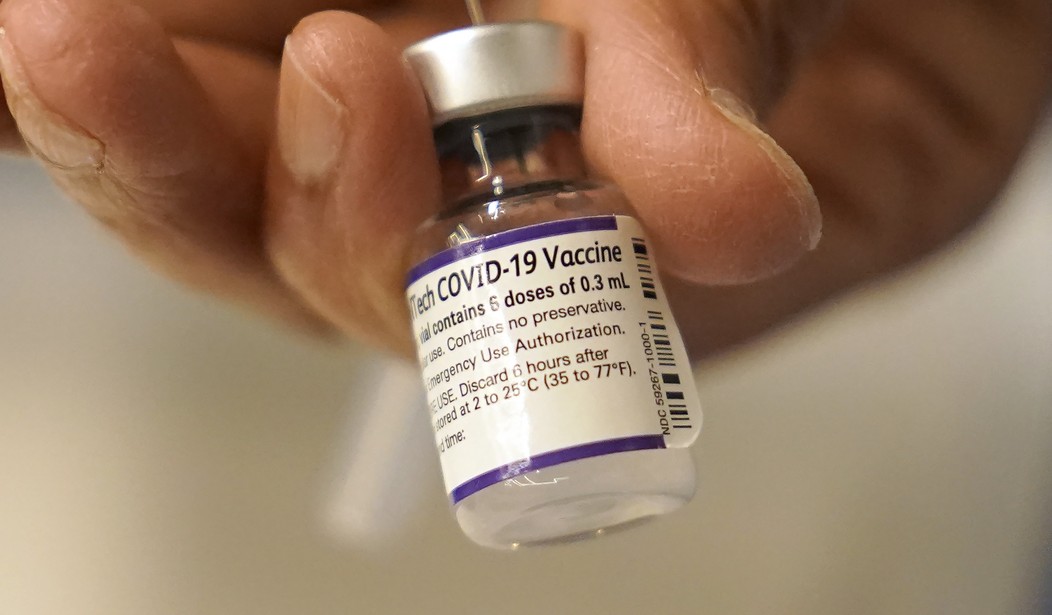Not exactly, but it certainly raises the possibility. A wide-ranging analysis published to little initial fanfare on December 1 reviewed Medicare data for outcomes for more than 30 million recipients of Pfizer’s COVID vaccine above the age of 65. The first pass of the data showed “statistical signals” to four potential adverse outcomes, but subsequent reviews limited the signal to just one: a potential causal link between this particular vaccine and a type of pulmonary embolism:
Methods
We evaluated 14 outcomes of interest following COVID-19 vaccination using the US Centers for Medicare & Medicaid Services (CMS) data covering 30,712,101 elderly persons. The CMS data from December 11, 2020 through Jan 15, 2022 included 17,411,342 COVID-19 vaccinees who received a total of 34,639,937 doses. We conducted weekly sequential testing and generated rate ratios (RR) of observed outcome rates compared to historical (or expected) rates prior to COVID-19 vaccination.Findings
Four outcomes met the threshold for a statistical signal following BNT162b2 vaccination including pulmonary embolism (PE; RR = 1.54), acute myocardial infarction (AMI; RR = 1.42), disseminated intravascular coagulation (DIC; RR = 1.91), and immune thrombocytopenia (ITP; RR = 1.44). After further evaluation, only the RR for PE still met the statistical threshold for a signal; however, the RRs for AMI, DIC, and ITP no longer did. No statistical signals were identified following vaccination with either the mRNA-1273 or Ad26 COV2.S vaccines.
What does this mean? Nothing conclusive, at least not yet. The study’s authors urge more epidemiological studies to pursue the statistically significant link, presumably by the FDA and Pfizer. (One key point to remember — this is a data study, not a physical study.) They still endorse vaccination otherwise, and note that the other two vaccines in use apparently didn’t demonstrate any statistical signals for these adverse outcomes:
Interpretation
This early warning system is the first to identify temporal associations for PE, AMI, DIC, and ITP following BNT162b2 vaccination in the elderly. Because an early warning system does not prove that the vaccines cause these outcomes, more robust epidemiologic studies with adjustment for confounding, including age and nursing home residency, are underway to further evaluate these signals. FDA strongly believes the potential benefits of COVID-19 vaccination outweigh the potential risks of COVID-19 infection.
The Epoch Times first picked up on this study on Saturday, but it hasn’t had much traction since with mainstream media outlets. The International Business Times reported mainly on the social-media reaction to the news, but it did also provide some background on the study:
The study was jointly conducted by the researchers from US Food and Drug Administration, Acumen LLC, Department of Economics, Stanford University, and Centers for Medicare and Medicaid Services. …
Speaking to the outlet, Dr. Peter McCullough, chief medical adviser for the Truth for Health Foundation, said that the new paper “corroborates the concerns of doctors that the large uptick in blood clots, progression of atherosclerotic heart disease, and blood disorders is independently associated with COVID-19 vaccination.”
Again, that’s not exactly what this study claims. As usual with these kinds of studies, the authors took care not to jump to conclusions. In fact, the main body of the report states that they cannot be sure yet that the link is causal rather than correlative. However, the statistical signal between Pfizer’s vaccine and PEs is strong enough to warrant a deeper investigation:
The statistical signals of four serious outcomes are not necessarily causal and may be due to factors potentially unrelated to vaccination. Additional analyses indicated that the potential association was less than twice the historical rates and may be associated with factors not accounted for in the near real-time surveillance methods. For example, the elderly Medicare population that received the BNT162b2 vaccine differed from other elderly COVID-19 vaccinated populations, including a preponderance of nursing home residents and populations with a higher comorbidity burden. These demographic and medical differences were not fully accounted for, since expected rates were only standardized to a subset of characteristics – age, sex, race, and nursing home residency status. Further, the AMI, DIC, and ITP signals were not robust when additional baseline rates were evaluated, while the PE signal might be explained by differences in rates between the pre-COVID-19 and peri-COVID-19 periods. In addition, the clinical assessment of patterns of reimbursement codes indicated that a substantial fraction had pre-existing outcome-specific comorbidities and risk factors, and that some outcomes may be due to follow-up care to an existing condition preceding the vaccination.
The bottom line from the study: A novel vaccine rushed to market to deal with a rapidly spreading novel vaccine may have some serious side effects for a limited number of its target demographic. This should not be a surprise; this is precisely why the FDA usually requires significant studies before allowing vaccines or other medications to get to the market. The pandemic was an emergency that arguably required a streamlined approval to deal with the arguably higher risks of COVID-19, but that always had a significant trade-off for safety.
The problem until now is that government and mainstream media insisted that it didn’t involve a trade-off for safety. Not only did they declare the vaccines entirely safe without any long- or even medium-range studies for potential impacts, they actively quashed any inquiry into such issues. Even medical professionals who raised concerns over the mass uptake of largely untested vaccines with only the most cursory of studies got marginalized as “deniers,” banned from social media, and in some cases lost jobs.
That may be many things, but it is not science. It’s more like Scientism, a religious system in which high priests do not suffer questions and the dogma is always settled. And in service for what? A series of vaccines that doesn’t actually stop uptake or transmission, although it does show effectiveness at limiting the impact of acute cases, especially at population level measures.
It’s time to start asking questions, serious questions, about government/MSM management of The Science. In fact, it was always time to ask these questions and to demand answers. Adam Baldwin and I will have more on this in today’s Amiable Skeptics show this morning.








Join the conversation as a VIP Member